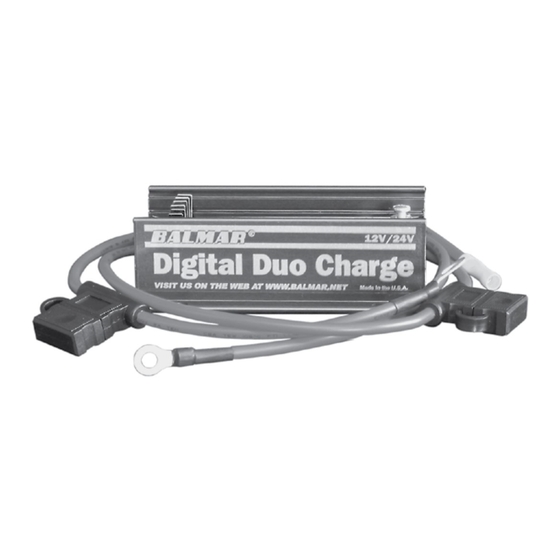Balmar Digital Duo Charge Installatie- en bedieningshandleiding - Pagina 4
Blader online of download pdf Installatie- en bedieningshandleiding voor {categorie_naam} Balmar Digital Duo Charge. Balmar Digital Duo Charge 8 pagina's.
Ook voor Balmar Digital Duo Charge: Installatie- en bedieningshandleiding (4 pagina's)

Battery Temperature Sensor
When used in conjunction with the optional MC-TS-B Battery Temperature Sensor, the Duo Charge can automatically re-
spond to a potential battery thermal runaway by discontinuing charging output to the starting battery — adding a level of
safety to the charging system. To install the MC-TS-B Battery Temperature Sensor:
1.
Attach the lug that houses the sensor module to the
2.
Using care to match polarity between the temperature sensor positive and negative wires and the positive and nega-
tive temperature sensor terminal pins on the Duo Charge, connect wires to the terminal pins.
Solenoid Drive
In applications where the Duo Charge is used to support larger capacity starting batteries (such as 4D and 8D models) or
windlass and/or thruster batteries, there may be instances when the 30-amp capacity of the Duo Charge's circuitry may not
provide sufficient current to satisfy demands. When used as a stand alone charge source, the Duo Charge is designed to
discontinue charging when demands exceed its capabilities. At that point, the Duo Charge will wait for a short period and
query if the demand has diminished to below its 30-amp capacity. If so, the Duo Charge will continue charging. If demand
continues to exceed capacity, the Duo Charge will continue to shut down, while checking periodically to see if demand has
diminished.
If your application requires frequent charging levels in excess of 30 amps, it may be necessary to add a solenoid as a method
to manually bypass the Duo Charge's internal circuitry. Keep in mind, the Duo Charge will not automatically activate the so-
lenoid if the demand exceeds its capacity. As such, it is important to monitor charging voltage closely at the battery being
charged by the Duo Charge. To utilize the Duo Charge's solenoid drive function, it will be necessary for the user to supply an
appropriate-capacity solenoid and a toggle or other ON/OFF
switching mechanism to control the bypass func tion.
To install the external solenoid control circuit:
1.
Install solenoid between primary and secondary battery
banks. Ensure that solenoid is properly sized to handle
maximum current flow. Ensure that wire gauge is ade-
quate to supply maximum current flow.
2.
Connect positive solenoid relay terminal to a source of
positive system voltage.
3.
Connect the negative solenoid relay to the Solenoid Drive
terminal on the Duo Charge.
4.
Create a switched circuit between system ground and the
Auto/Manual terminal on the Duo Charge.
Once installed, the Duo Charge will be in the Auto mode
whenever the toggle switch is in the OFF position, and charg-
ing will occur via the Duo Charge's internal circuitry. When the
toggle switch is in the ON position, the Duo Charge will revert
to manual mode, allowing the solenoid to control charge flow
to the secondary battery bank.
negative post of the starting battery.
4
